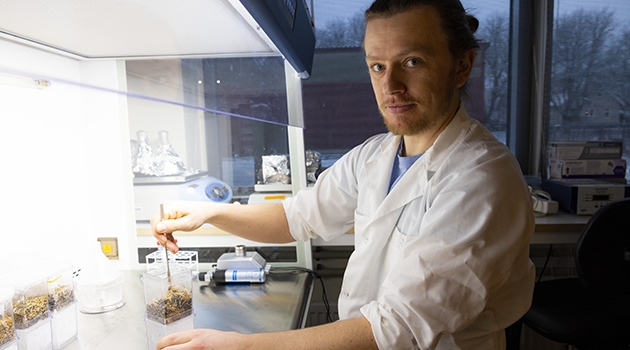Worms, bacteria and fungi help reduce carbon dioxide emissions
Can we use the Earth's own natural thermostat and accelerate the process to help reduce global warming? Promising progress has been made in the research project BAM (Bio-Accelerated Mineral Weathering). With the help of worms, bacteria and fungi researchers are trying to make stone weather faster and in this way capture carbon dioxide.
Weathering is the process by which stone is mechanically or chemically broken down to gravel, sand, clay and ions. These ions can then react with each other and precipitate out as new minerals and rocks. In this way carbon dioxide can be bound in limestone, and this is what the researchers behind BAM are trying to achieve.
“On a geological time-scale, the weathering of silicate minerals has helped to regulate the Earth's temperature. We are trying to enhance these processes as they naturally occur too slowly. That's the idea behind this technology,” explains Thomas Corbett, postdoctoral researcher at the Department of Earth Sciences.
Promising results
By mixing specially chosen organisms with crushed stone and hay in a sealed container, researchers have already shown promising results and have managed to double the rate of weathering. This rate still needs to be increased many times over in order to be truly effective.
Specially designed bioreactors will be used to achieve this. The first prototype will soon be ready. The basic principle is based on water and carbon dioxide being led into a chamber containing crushed stone, bacteria and fungi. The chamber also contains organic material, for example hay, which the organisms can feed on as well as worms whose main role is to stir up the material.
Out of the chamber trickles leachate that can then be returned to the environment. It is hoped that due to the high alkalinity of the leachate it can help to reduce ocean acidification.
“We have started with relatively small reactors which we fill with about 400 grams of material and we will then scale up from there. We use thousands of these small through-flow reactors to identify the best combination of organisms and flowrate through the reactor,” explains Corbett.
Directly at the source
The idea is that this type of bioreactor could clean carbon dioxide emissions directly at the source, for example a factory or industrial plant. Eventually, the researchers hope that concrete waste and slag from steel production, for example, could be processed in the bioreactors, as this would be good for both the climate and the environment.
particular one contains straw and fragments of
volcanic rock from the volcanic eruption at La
Palma in 2021. Photo: Mikael Wallerstedt
Before reaching that stage, however, the most important thing is to identify the optimal combinations of decomposers and easily weathered stones.
“We use several different types of fungi and bacteria grown by us. There are genetically modified species that have a very high rate of weathering, but these also entail other challenges that we try to avoid. We are focusing on using wild, non-pathogenic species so that any risk to the environment or to people handling them is minimised,” explains Corbett, whose role in the project is to identify suitable fungi and bacteria.
Native species
Using native species is important for ensuring that no damage is caused to the ecosystem when the organisms leave the bioreactors, both within the leachate water and when the material in the chamber is periodically replaced in order to maintain the rate of weathering. The waste is planned for use as fertiliser, where the processes of weathering will continue, albeit at a much more modest rate than in the bioreactors.
Once the carbon dioxide has been converted to limestone, it can no longer reach the atmosphere and therefore does not contribute to global warming. Methods of capturing carbon dioxide are imperative, according to the UN Intergovernmental Panel on Climate Change, if we are to achieve the climate targets. According to the researchers, BAM on its own can't solve the climate crisis, but it can be part of the solution.
“This is a technology that can be combined with other technologies for negative emissions and, hopefully, contribute to reducing emissions,” says Corbett.
Åsa Malmberg
About BAM
BAM (Bio Accelerated Mineral Weathering) is an interdisciplinary co-operation between Uppsala University, Universität Hamburg and Wageningen University and Research. The project is funded by the European Innovation Council.

